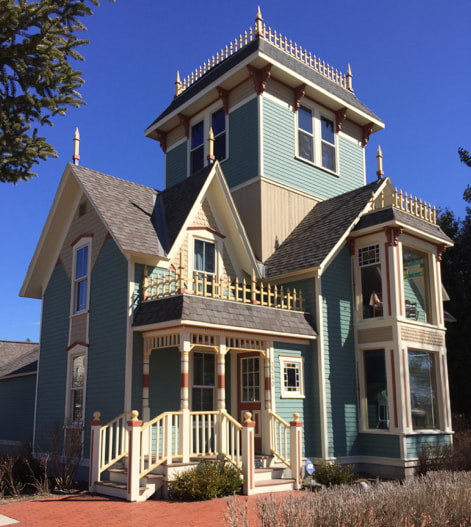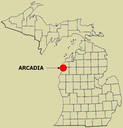Arcadia History Museum
Please visit the Arcadia Museum website
1880 - Area construction escalates to support the booming lumber industry and the necessities of a growing town.A sawmill is built by the Starke Bros. in what is called Starkeville. A second sawmill is built by H. Brown. The Huntington & Co. sawmill closes.Construction begins on the 130 ft. bridge pier in Lake Michigan at the end of Lake Street. The pier would later be extended to 1000 ft.Also built: three school houses and a boarding house.
1881 - Village lots are platted. They were sold for $25 per lot.The first lumber is shipped from the pier. The schooner Arab makes regular trips back and forth across the lake. Construction begins on the road east to Pleasanton and a narrow gauge railway, the beginning of the Arcadia & Betsey River Railway.
1882 - The village of Burnham is founded two miles north of Starkieville on the shore of Lake Michigan.
1883 - A post office is established in Arcadia Township, and the village is renamed Arcadia. The area and its businesses continue to grow and thrive.The Schooner Arab shipwrecks twice. The second one is a permanent loss.
1888 - Timbers and planking are cut in the local mill and shipped to Milwaukee where the steamer Arcadia is constructed. The Arcadia is used primarily to haul lumber.
1892 - Construction begins on a channel between Bar Lake and Lake Michigan and a harbor, so ships can enter the lake and tie up at docks built along the shore line.
1893 - The channel and harbor are completed. Bar Lake becomes a safe harbor for shipping on the Great Lakes.The pier in Lake Michigan is no longer used. The conversion from narrow gauge to standard gauge begins for the Arcadia & Betsey River Railway. The goal is to connect the railroad to the Chicago and West Michigan Railway at Henry. The Minnehaha wrecks in an autumn gale. Pieces of this 200 ft., 4-masted schooner wash up on the shore near Arcadia.
1894 - At least 507 large vessels use the harbor. Many more smaller, uncounted vessels use the harbor too.
1895 - By September, the A&BRR extends 17.5 miles to Henry, where it connects with the Chicago and West Michigan Railway. The Arcadia & Betsey River Railway (A&BRR) standard gauge railroad is in operation.The combination of lumbering, farming, other local industry, and good transportation by both rail and ship makes Arcadia a major hub in northwest Michigan.
1896 - By December, the A&BRR reaches Copemish, where it connects with the Ann Arbor Railroad. Passenger service is added.The A&BRR might interchange with the Manistee & Northeastern Railroad in Copemish and the narrow gauge logging railroad, the Bear Lake & Eastern Railroad, at Springdale between Henry and Copemish.
1897 - A telephone line is installed running 21 miles from Arcadia to Copemish.
1898 - Henry Starke, founder of the village of Arcadia, dies. Buffalo Bill’s Wild West Show performs in Manistee.
1899 - The A&BRR provides passenger service twice a day and carries 3,000 passengers and the mail.
1900 - The Chicago & West Michigan Railway, which connects to the Arcadia & Betsey River Railway at Henry, merges into the Pere Marquette Railroad. At least 514 large vessels use the harbor.
1902 - Act of 1902 orders an examination of the Arcadia harbor to estimate the cost of maintaining the piers and channel. District Officer of the Corp of Engineers states that, for proper maintenance of the harbor, both piers would have to be rebuilt and the north pier extended at a cost of about $90,000. (The harbor was built and maintained privately from 1892 through 1906 for about $75,000.)
In their review of this report, the Board of Engineers for Rivers and Harbors agrees with the District Officer that the expenditure of $90,000 plus $5,000 annually for maintenance is justified by the amount of local commerce. However, the Board decides to dredge the channel for five years at $3,000 per year and decide at the end of that time whether to do more.
1904 - Private interests continue to improve and maintain the harbor, which is free for public use and open from the earliest to the latest dates of navigation each season. Throughout this 13-year period, the channel is dredged properly to a depth of 14 feet, and the piers are kept in good repair. Arcadia’s harbor supports interstate commerce between this area and cities across Lake Michigan.
1905 - Federal support for the channel begins. The US Government begins a program of trying to keep the channel open by dredging only, not by making any repairs to the piers.
1880 - Area construction escalates to support the booming lumber industry and the necessities of a growing town.A sawmill is built by the Starke Bros. in what is called Starkeville. A second sawmill is built by H. Brown. The Huntington & Co. sawmill closes.Construction begins on the 130 ft. bridge pier in Lake Michigan at the end of Lake Street. The pier would later be extended to 1000 ft.Also built: three school houses and a boarding house.
1881 - Village lots are platted. They were sold for $25 per lot.The first lumber is shipped from the pier. The schooner Arab makes regular trips back and forth across the lake. Construction begins on the road east to Pleasanton and a narrow gauge railway, the beginning of the Arcadia & Betsey River Railway.
1882 - The village of Burnham is founded two miles north of Starkieville on the shore of Lake Michigan.
1883 - A post office is established in Arcadia Township, and the village is renamed Arcadia. The area and its businesses continue to grow and thrive.The Schooner Arab shipwrecks twice. The second one is a permanent loss.
1888 - Timbers and planking are cut in the local mill and shipped to Milwaukee where the steamer Arcadia is constructed. The Arcadia is used primarily to haul lumber.
1892 - Construction begins on a channel between Bar Lake and Lake Michigan and a harbor, so ships can enter the lake and tie up at docks built along the shore line.
1893 - The channel and harbor are completed. Bar Lake becomes a safe harbor for shipping on the Great Lakes.The pier in Lake Michigan is no longer used. The conversion from narrow gauge to standard gauge begins for the Arcadia & Betsey River Railway. The goal is to connect the railroad to the Chicago and West Michigan Railway at Henry. The Minnehaha wrecks in an autumn gale. Pieces of this 200 ft., 4-masted schooner wash up on the shore near Arcadia.
1894 - At least 507 large vessels use the harbor. Many more smaller, uncounted vessels use the harbor too.
1895 - By September, the A&BRR extends 17.5 miles to Henry, where it connects with the Chicago and West Michigan Railway. The Arcadia & Betsey River Railway (A&BRR) standard gauge railroad is in operation.The combination of lumbering, farming, other local industry, and good transportation by both rail and ship makes Arcadia a major hub in northwest Michigan.
1896 - By December, the A&BRR reaches Copemish, where it connects with the Ann Arbor Railroad. Passenger service is added.The A&BRR might interchange with the Manistee & Northeastern Railroad in Copemish and the narrow gauge logging railroad, the Bear Lake & Eastern Railroad, at Springdale between Henry and Copemish.
1897 - A telephone line is installed running 21 miles from Arcadia to Copemish.
1898 - Henry Starke, founder of the village of Arcadia, dies. Buffalo Bill’s Wild West Show performs in Manistee.
1899 - The A&BRR provides passenger service twice a day and carries 3,000 passengers and the mail.
1900 - The Chicago & West Michigan Railway, which connects to the Arcadia & Betsey River Railway at Henry, merges into the Pere Marquette Railroad. At least 514 large vessels use the harbor.
1902 - Act of 1902 orders an examination of the Arcadia harbor to estimate the cost of maintaining the piers and channel. District Officer of the Corp of Engineers states that, for proper maintenance of the harbor, both piers would have to be rebuilt and the north pier extended at a cost of about $90,000. (The harbor was built and maintained privately from 1892 through 1906 for about $75,000.)
In their review of this report, the Board of Engineers for Rivers and Harbors agrees with the District Officer that the expenditure of $90,000 plus $5,000 annually for maintenance is justified by the amount of local commerce. However, the Board decides to dredge the channel for five years at $3,000 per year and decide at the end of that time whether to do more.
1904 - Private interests continue to improve and maintain the harbor, which is free for public use and open from the earliest to the latest dates of navigation each season. Throughout this 13-year period, the channel is dredged properly to a depth of 14 feet, and the piers are kept in good repair. Arcadia’s harbor supports interstate commerce between this area and cities across Lake Michigan.
1905 - Federal support for the channel begins. The US Government begins a program of trying to keep the channel open by dredging only, not by making any repairs to the piers.

